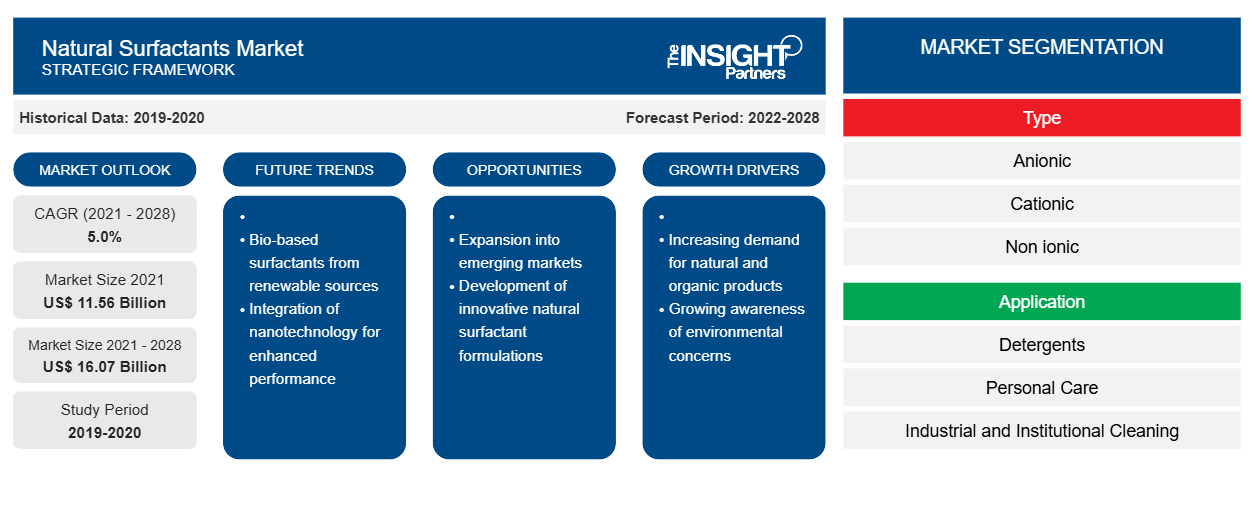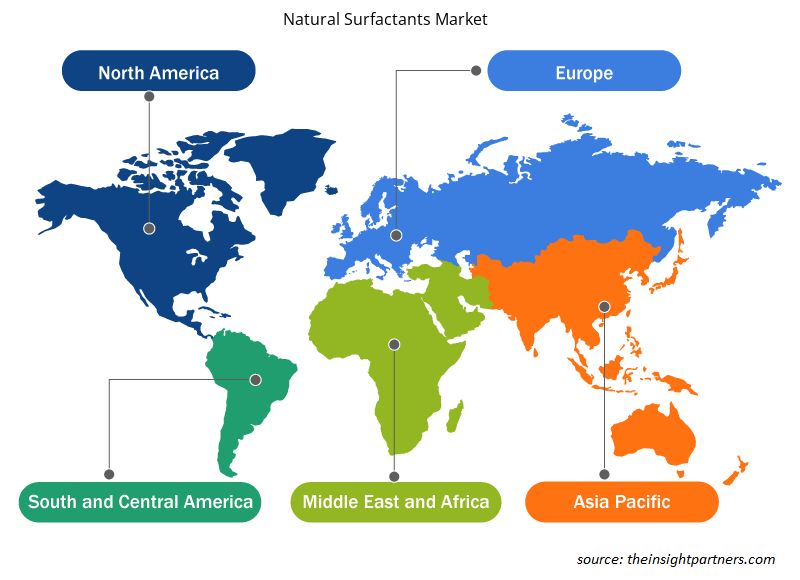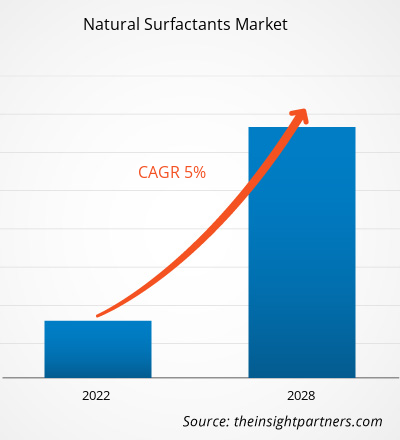[Research Report] The natural surfactants market is expected to grow from US$ 11,558.34 million in 2021 to US$ 16,069.28 million by 2028; it is estimated to grow at a CAGR of 5.0% from 2022 to 2028.
Natural surfactants are derived from different types of plants. Common sources include coconut or palm, but they can also be derived from other types of vegetables and fruits. In addition, natural surfactants can also be produced from industrial wastes and by-products. Natural surfactants were more easily biodegradable than their synthetic counterparts due to their biological origin.
In 2021, Asia Pacific held the largest revenue share of the global natural surfactants market. Major factors driving the natural surfactants market in Asia Pacific are increasing awareness of the benefits of natural surfactants and their increasing use in different applications such as detergents, cosmetics and personal care, industrial cleaning, and agriculture. Chemically synthesized surfactants, being petroleum-based, are usually nonbiodegradable and toxic to the environment. The production processes of synthetic surfactants and by-products can be hazardous to the environment. As a result, there is an increasing awareness of the need to protect the environment. Therefore, the use of natural surfactants is increasing in the region, which is driving the natural surfactant market growth in Asia Pacific.
Customize This Report To Suit Your Requirement
You will get customization on any report - free of charge - including parts of this report, or country-level analysis, Excel Data pack, as well as avail great offers and discounts for start-ups & universities
Natural Surfactants Market: Strategic Insights

- Get Top Key Market Trends of this report.This FREE sample will include data analysis, ranging from market trends to estimates and forecasts.
You will get customization on any report - free of charge - including parts of this report, or country-level analysis, Excel Data pack, as well as avail great offers and discounts for start-ups & universities
Natural Surfactants Market: Strategic Insights

- Get Top Key Market Trends of this report.This FREE sample will include data analysis, ranging from market trends to estimates and forecasts.
Impact of COVID-19 Pandemic on Natural Surfactants Market
Before the COVID-19 pandemic, the natural surfactant market has been mainly driven by their increasing use in various industries such as personal care, detergents, industrial and institutional cleaning, oilfield chemicals, agriculture chemicals, and others. However, in 2020, various industries had to slow down their operations due to disruptions in value chains caused by the shutdown of national and international boundaries. The COVID-19 pandemic caused supply chain disruptions in key raw materials and hampered manufacturing processes due to restrictions imposed by government authorities in numerous countries. The demand for natural surfactants from various industries decreased owing to the shutdown of the industries.
The demand for personal hygiene and homecare goods grew due to the COVID-19 pandemic, which has positively impacted the production of natural surfactants for households and other applications. Moreover, the natural surfactant has a key role in combatting the pandemic. Common natural surfactants are used in soaps and other personal cleansing products, laundry detergents, and solid surface cleaners to deactivate SARS-CoV-2 and remove it from the skin and other surfaces.
Market Insights
Increasing Demand for Detergents in Household Application
With the rising prevalence of infectious diseases, especially COVID-19, people are becoming more aware of cleanliness and hygiene. The significance of hand sanitization, hygiene, and cleanliness has increased because of the rapidly emerging infectious diseases such as norovirus and influenza. The need for detergents in household applications is growing due to the increased usage of laundry detergents and household cleaning goods.
Detergents are commonly used for cleaning because they connect water and oil, making them effective against oily stains and grease. Healthcare professionals are running hygiene awareness campaigns in several developing nations to draw customers' attention and raise awareness. As a result, consumers’ demand for personal care and household cleaning goods is increasing.
Type Insights
Based on type, the global natural surfactants market is segmented into anionic, cationic, non ionic, and amphoteric. The anionic segment held the largest natural surfactants market share in 2021. Anionic surfactants are characterized by a negatively charged hydrophilic polar group. They are the most commonly used surfactants owing to their best cleaning power and a large amount of foam produced. These surfactants are the best at cleaning, as they clean using charged repulsion. Anionic surfactants are excellent in removing dirt, clay, and some oily stains. These anionic surfactants can be found in shampoos, shower gels, toothpaste, etc. Glutamate, potassium cocoate, isethionate, and sodium coco sulfate are some of the examples of natural anionic surfactants.
A few players operating in the global natural surfactants market include BASF SE, Clariant AG, Croda International Plc, Dow Inc., KAO Corporation, Lankem Ltd., Solvay S.A., Arkema, Stepan Company, and Evonik Industries AG. Players operating in the natural surfactants maket are focusing on providing high-quality products to fulfill customer demand. They are also focusing on strategies such as investments in research and development activities and new product launches.
Report Spotlights
- Progressive industry trends in the natural surfactants market to help players develop effective long-term strategies
- Business growth strategies adopted by developed and developing markets
- Quantitative analysis of the natural surfactants market from 2020 to 2028
- Estimation of global demand for natural surfactants
- Porter’s Five Forces analysis to illustrate the efficacy of buyers and suppliers operating in the industry
- Recent developments to understand the competitive market scenario
- Market trends and outlook as well as factors driving and restraining the growth of the natural surfactants market
- Assistance in decision-making process by highlighting market strategies that underpin commercial interest, leading to the Natural Surfactants Market natural surfactants market growth
- The natural surfactants market size at various nodes
- Detailed overview and segmentation of the market, as well as the natural surfactants industry dynamics
- Size of the natural surfactants market in various regions with promising growth opportunities
Natural Surfactants Market Regional Insights
The regional trends and factors influencing the Natural Surfactants Market throughout the forecast period have been thoroughly explained by the analysts at Insight Partners. This section also discusses Natural Surfactants Market segments and geography across North America, Europe, Asia Pacific, Middle East and Africa, and South and Central America.

- Get the Regional Specific Data for Natural Surfactants Market
Natural Surfactants Market Report Scope
| Report Attribute | Details |
|---|---|
| Market size in 2021 | US$ 11.56 Billion |
| Market Size by 2028 | US$ 16.07 Billion |
| Global CAGR (2021 - 2028) | 5.0% |
| Historical Data | 2019-2020 |
| Forecast period | 2022-2028 |
| Segments Covered |
By Type
|
| Regions and Countries Covered | North America
|
| Market leaders and key company profiles |
Natural Surfactants Market Players Density: Understanding Its Impact on Business Dynamics
The Natural Surfactants Market is growing rapidly, driven by increasing end-user demand due to factors such as evolving consumer preferences, technological advancements, and greater awareness of the product's benefits. As demand rises, businesses are expanding their offerings, innovating to meet consumer needs, and capitalizing on emerging trends, which further fuels market growth.
Market players density refers to the distribution of firms or companies operating within a particular market or industry. It indicates how many competitors (market players) are present in a given market space relative to its size or total market value.
Major Companies operating in the Natural Surfactants Market are:
- BASF SE
- Clariant AG
- Croda International Plc
- Dow Inc.
- KAO Corporation
Disclaimer: The companies listed above are not ranked in any particular order.

- Get the Natural Surfactants Market top key players overview
Global Natural Surfactants Market
By Type
- Anionic
- Glutamate
- Potassium Cocoate
- Isethionate
- Others
- Cationic
- Brassicyl Isoleucinate Esylate
- Dialkylester Ammonium Methosulfate
- Esterquat Benzalkonium Chloride
- Polyquaternium
- CTAC (Cetrimonium Chloride)
- BTAC (Behentrimonium Chloride)
- Others
- Non ionic
- Saponins
- Glucosides
- Glycerides
- Ethoxylates
- Cocamide MEA (CMEA)
- Cocamide DEA (CDEA)
- Others
- Amphoteric
- Betains
- Amphoacetates
- Sultaines
- Amine Oxides and Others
By Application
- Detergents
- Personal Care
- Industrial and Institutional Cleaning
- Oilfield Chemicals
- Agriculture Chemicals
- Others
Company Profiles
- BASF SE
- Clariant AG
- Croda International Plc
- Dow Inc.
- KAO Corporation
- Lankem Ltd.
- Solvay S.A.
- Arkema
- Stepan Company
- Evonik Industries AG
Frequently Asked Questions
What are the key factors influencing market growth?
The global natural surfactants market is primarily driven by increasing demand for detergents in household application and growing requirement for nontoxic and highly biodegradable products.
Which region held the fastest CAGR in the global natural surfactants market?
Asia Pacific is estimated to register the fastest CAGR in the global natural surfactants market over the forecast period. This is mainly attributed to an increasing use of natural surfactants in different application fields and an innovative research on natural surfactants.
Based on application, which segment is leading the global natural surfactants market during the forecast period?
The detergents segment held the largest share of the global natural surfactants market in 2021. Natural surfactant’s excellent compatibility and stability is favoring their inclusion in the formulation of laundry detergents.
Based on type, which segment is leading the global natural surfactants market during the forecast period?
The anionic segment held the largest share of the global natural surfactants market in 2021. Anionic surfactants are characterized by a negatively charged hydrophilic polar group. Anionic surfactants are highly used in shampoos, shower gels, toothpaste, etc.
Which region held the largest share of the global natural surfactants market?
In 2021, Asia Pacific held the largest share of the global natural surfactants market. Increasing awareness of the benefits of natural surfactants and their increasing use in different application fields are mainly driving the natural surfactants market in Asia Pacific.
Can you list some of the major players operating in the global natural surfactants market?
Major players operating in the global natural surfactants market includes, BASF SE, Clariant AG, Croda International Plc, Dow Inc., KAO Corporation, Lankem Ltd., Solvay S.A., Arkema, Stepan Company, and Evonik Industries AG.
- Historical Analysis (2 Years), Base Year, Forecast (7 Years) with CAGR
- PEST and SWOT Analysis
- Market Size Value / Volume - Global, Regional, Country
- Industry and Competitive Landscape
- Excel Dataset
Testimonials
I wish to appreciate your support and the professionalism you displayed in the course of attending to my request for information regarding to infectious disease IVD market in Nigeria. I appreciate your patience, your guidance, and the fact that you were willing to offer a discount, which eventually made it possible for us to close a deal. I look forward to engaging The Insight Partners in the future, all thanks to the impression you have created in me as a result of this first encounter.
DR CHIJIOKE ONYIA, MANAGING DIRECTOR, PineCrest Healthcare Ltd.The Insight Partners delivered insightful, well-structured market research with strong domain expertise. Their team was professional and responsive throughout. The user-friendly website made accessing industry reports seamless. We highly recommend them for reliable, high-quality research services
Yukihiko Adachi CEO, Deep Blue, LLC.Reason to Buy
- Informed Decision-Making
- Understanding Market Dynamics
- Competitive Analysis
- Customer Insights
- Market Forecasts
- Risk Mitigation
- Strategic Planning
- Investment Justification
- Identifying Emerging Markets
- Enhancing Marketing Strategies
- Boosting Operational Efficiency
- Tracking Industry Innovations
- Aligning with Regulatory Trends
Yes! We provide a free sample of the report, which includes Report Scope (Table of Contents), report structure, and selected insights to help you assess the value of the full report. Please click on the "Download Sample" button or contact us to receive your copy.
Absolutely — analyst assistance is part of the package. You can connect with our analyst post-purchase to clarify report insights, methodology or discuss how the findings apply to your business needs.
Once your order is successfully placed, you will receive a confirmation email along with your invoice.
• For published reports: You’ll receive access to the report within 4–6 working hours via a secured email sent to your email.
• For upcoming reports: Your order will be recorded as a pre-booking. Our team will share the estimated release date and keep you informed of any updates. As soon as the report is published, it will be delivered to your registered email.
We offer customization options to align the report with your specific objectives. Whether you need deeper insights into a particular region, industry segment, competitor analysis, or data cut, our research team can tailor the report accordingly. Please share your requirements with us, and we’ll be happy to provide a customized proposal or scope.
The report is available in either PDF format or as an Excel dataset, depending on the license you choose.
The PDF version provides the full analysis and visuals in a ready-to-read format. The Excel dataset includes all underlying data tables for easy manipulation and further analysis.
Please review the license options at checkout or contact us to confirm which formats are included with your purchase.
Our payment process is fully secure and PCI-DSS compliant.
We use trusted and encrypted payment gateways to ensure that all transactions are protected with industry-standard SSL encryption. Your payment details are never stored on our servers and are handled securely by certified third-party processors.
You can make your purchase with confidence, knowing your personal and financial information is safe with us.
Yes, we do offer special pricing for bulk purchases.
If you're interested in purchasing multiple reports, we’re happy to provide a customized bundle offer or volume-based discount tailored to your needs. Please contact our sales team with the list of reports you’re considering, and we’ll share a personalized quote.
Yes, absolutely.
Our team is available to help you make an informed decision. Whether you have questions about the report’s scope, methodology, customization options, or which license suits you best, we’re here to assist. Please reach out to us at sales@theinsightpartners.com, and one of our representatives will get in touch promptly.
Yes, a billing invoice will be automatically generated and sent to your registered email upon successful completion of your purchase.
If you need the invoice in a specific format or require additional details (such as company name, GST, or VAT information), feel free to contact us, and we’ll be happy to assist.
Yes, certainly.
If you encounter any difficulties accessing or receiving your report, our support team is ready to assist you. Simply reach out to us via email or live chat with your order information, and we’ll ensure the issue is resolved quickly so you can access your report without interruption.















The List of Companies - Natural Surfactants Market
- BASF SE
- Clariant AG
- Croda International Plc
- Dow Inc.
- KAO Corporation
- Lankem Ltd.
- Solvay S.A.
- Arkema
- Stepan Company
- Evonik Industries AG






 Get Free Sample For
Get Free Sample For